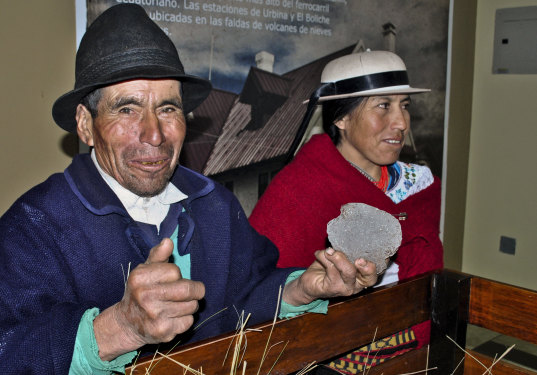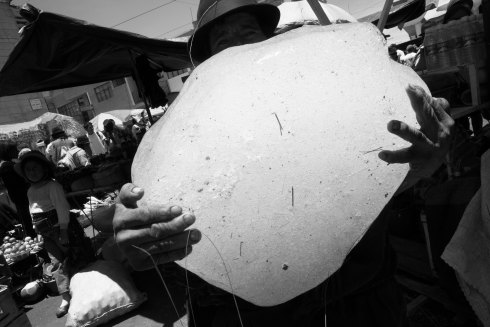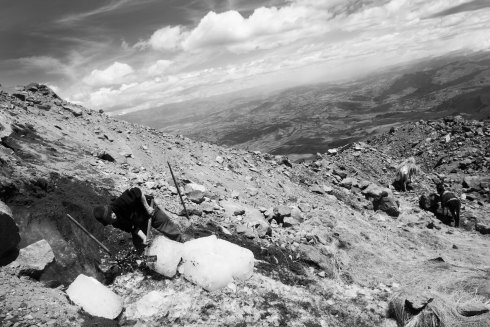This was published 7 months ago
The iceman of Ecuador cometh no more, ending 60-year tradition
At least once a week for more than 60 years, a man in a traditional black felt hat began a trek up Ecuador’s highest peak with donkeys at his side. For about five hours, they ascended a rocky path to a glacier located at about 15,000 feet on the southern face of a dormant volcano known as Chimborazo.
Baltazar Ushca chipped off chunks of milky-white ice, wrapped them in straw for insulation and headed down the slope with a frozen cargo that local lore says contains health-boosting properties.

Baltasar Ushca, the last ice merchant of Chimborazo, and his daughter, with a piece of natural ice from Chimborazo’s glacier.Credit: Getty Images
“Father Chimborazo looks after me,” said Ushca, who died on October 11, at age 80, and was believed to be the last in a centuries-old tradition of “hieleros del Chimborazo,” or ice harvesters on the mountain. The 4-foot-11 Ushca suffered fatal injuries after being knocked to the ground by a bull while he herded cattle, said a statement by the municipality of Guano, where Ushca lived.
The announcement called him “the last iceman of the majestic Chimborazo”.
In his younger years, Ushca was part of a family legacy that made a living off the Reschreiter glacier, whose ice was mostly used for refrigeration before electricity was widespread in their stretch of the Andes. “I would go with my mother and father, with my brothers and sisters,” he told the BBC in his native Quechua language. Other families, too, collected and sold ice from the glacier – sometimes bringing as many as 40 people to the mountain each week as recently as the 1960s.
As their numbers dwindled, Ushca’s renown grew as a caretaker of a vanishing way of life. He once took tourists on his trips to the glacier, but stopped when he realised that the travel companies kept most of the fees. Political leaders, including Ecuador’s then-president Rafael Correa, made stops to visit Ushca and celebrate his role in preserving the country’s cultural heritage.
When Ushca heard jealous comments about the attention, he had a favourite rebuke: “I tell them, just come and do my work.”

The “Ice Man”, Baltasar Ushca, was celebrated for preserving his country’s cultural heritage.Credit: Getty Images
In 2012, Ushca was flown to New York for the premiere of a 2012 documentary, El Último Hielero, or The Last Ice Merchant. The film’s director, Sandy Patch, called the experience of following Ushca to the glacier “akin to time travel.”
“Using just his hands and a pickaxe, he performs a task that would have looked no different hundreds of years ago,” Patch wrote in a 2015 essay in The New York Times.
Ushca also was a witness to the contemporary realities of climate change. The Reschreiter, the largest glacier on snow-capped Chimborazo, has receded by more than a kilometre – losing more than 20 per cent of its size – over the past four decades, according to scientific and mountaineering teams. That made Ushca’s climb longer but also more perilous. Rocky paths that were once held firm by ice have become loose and muddy. The risks of rockslides increased with each year.

Baltasar Ushca at work. Reschreiter, Chimborazo’s largest glacier, has receded by more than a kilometre over the decades he has been harvesting ice.Credit: Gamma-Rapho via Getty Images
For the villages around the mountain, spring run-off from snow and glaciers remains a critical water source. Shrinking glaciers – as well as floods from rapid melting – have opened questions about the future for farming communities under the more than 6248.4-metre peak just south of the equator.
As electric refrigerators replaced the Chimborazo ice, Ushca marketed his ice blocks (costing between $4 and $5 each) as a healthy specialty that could be mixed with fruit juices or used as part of artisanal ice cream. “The natural ice from Chimborazo is the best ice,” he said in the documentary. “The tastiest and sweetest, full of vitamins for your bones.”
Ushca and his donkeys normally set off about 7am from his village, Quatros Esquinas, with the temperature often below freezing. He rode one of the donkeys until the trail became steeper, and he would then lead them to the glacier, named for the German artist Rudolf Reschreiter, who painted scenes of Chimborazo in the early 20th century.
Ushca stopped on the ascent to collect straw to wrap the ice. He said he never wore gloves while working with the ice. One journalist who accompanied him in 2008 noticed that Ushca was barefoot under his boots.
On Saturdays, Ushca brought the ice blocks to a market in nearby Riobamba. “This is how we work because of poverty,” he told the BBC. “I am poor and I have no other choice.”
Baltazar Ushca Tenesaca was born in Riobamba in 1944. As a teenager, he became part of the family journeys to the glacier to harvest ice, he recounted. His two brothers eventually abandoned the work and became builders in the region.
At 73 – then a local celebrity – Ushca returned to the classroom to complete his primary school curriculum. Following his death, Ecuador’s National Institute of Cultural Heritage hailed Ushca as “a reference for the knowledge of our people” for preserving the traditions of the ice harvesters.
Complete information on survivors was not immediately available.
In the film El Último Hielero, one of Ushca’s sons, Juan, said he was often asked why he didn’t follow his father’s path as an iceman.
“But I can’t,” he said. “I tried, but I couldn’t do it like my father. I’m too weak to go there.”
The Washington Post
Start the day with a summary of the day’s most important and interesting stories, analysis and insights. Sign up for our Morning Edition newsletter.